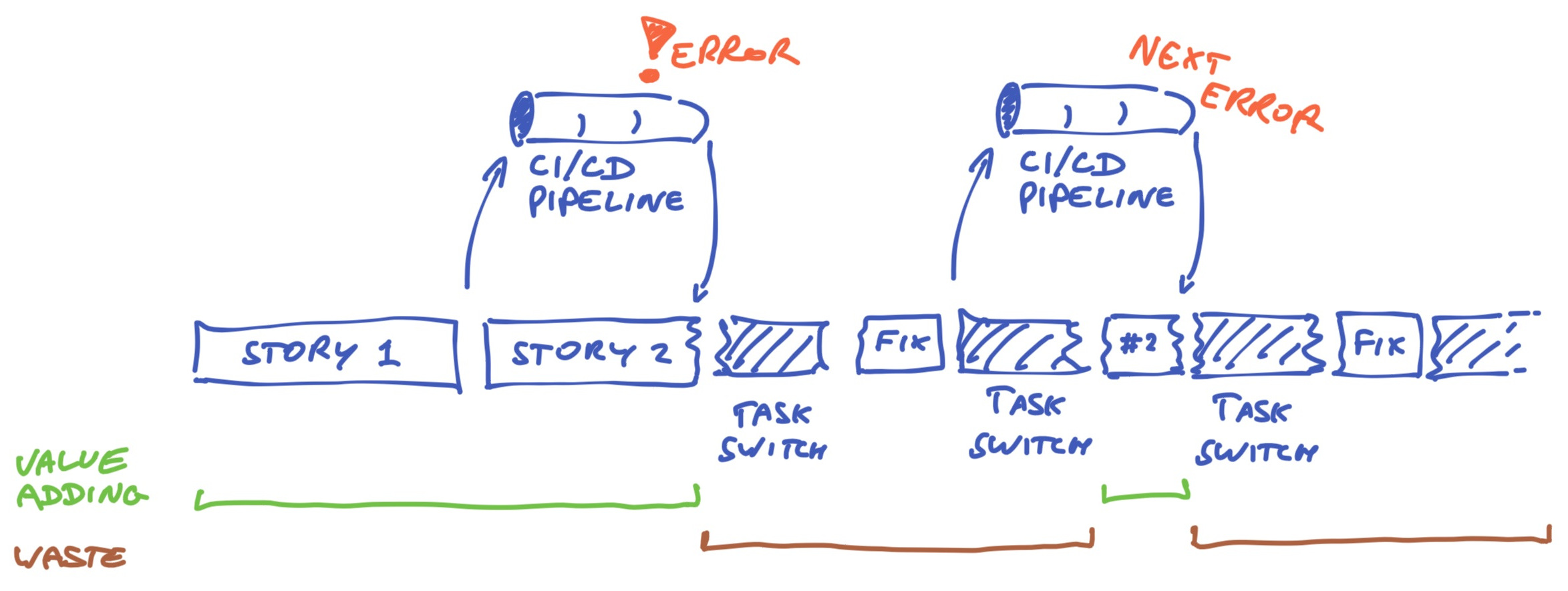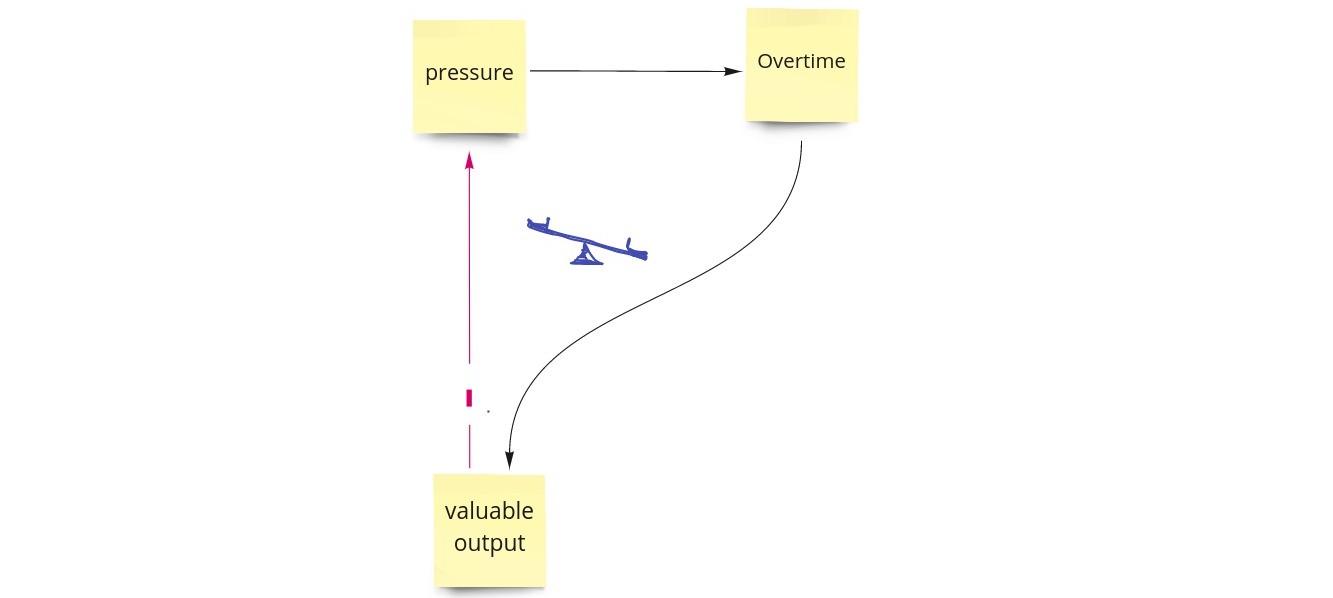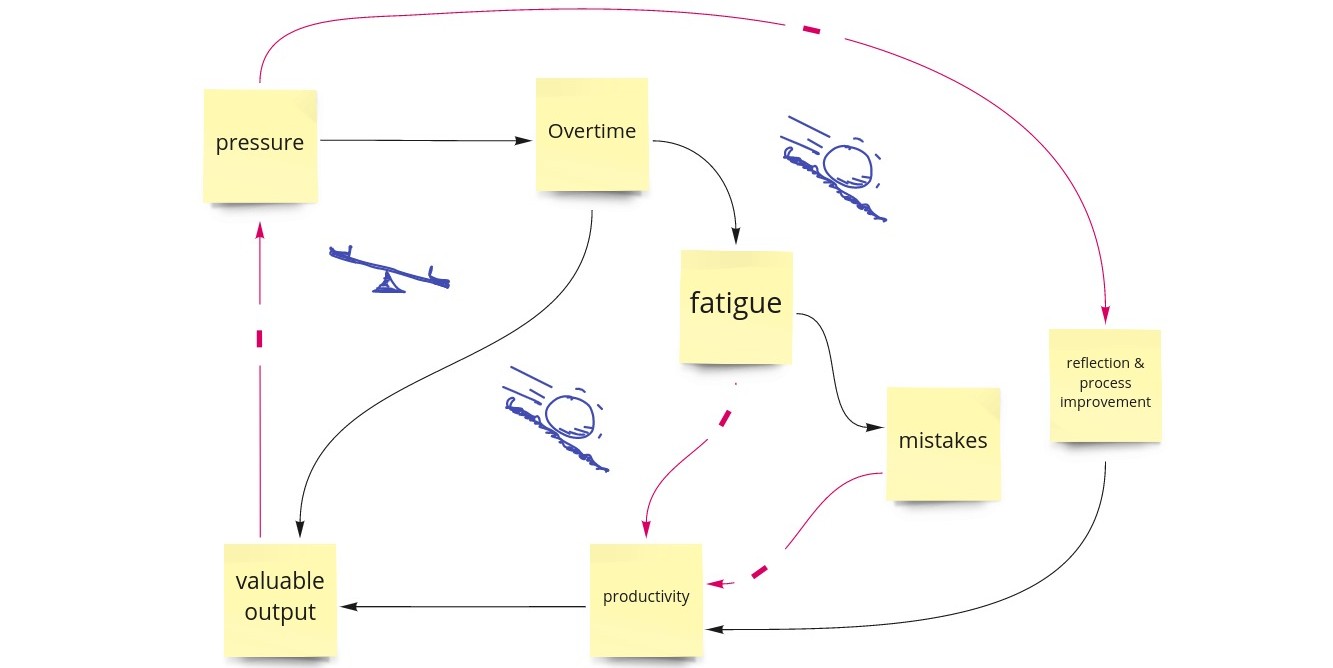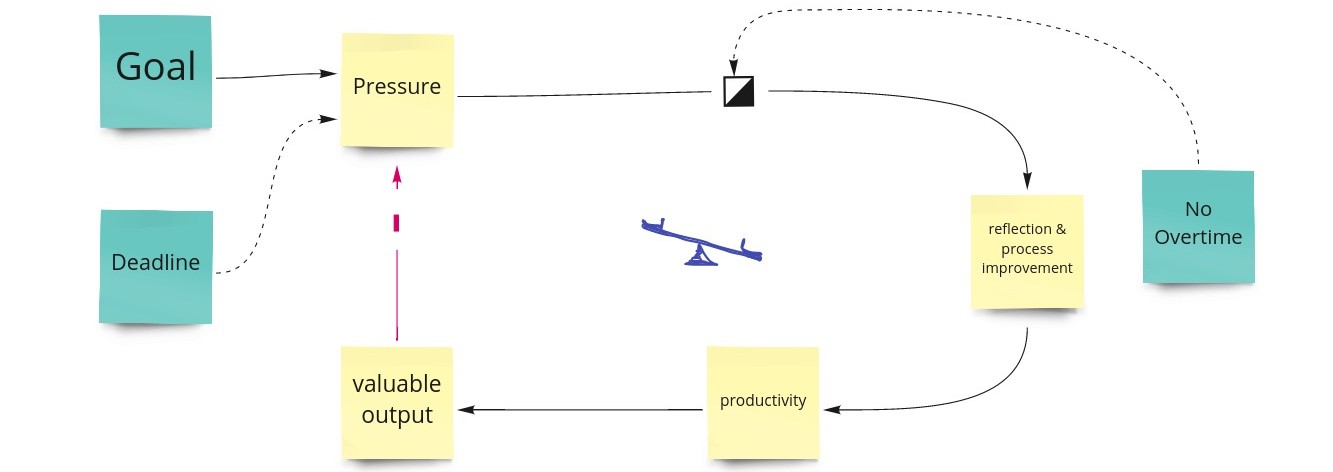Are you regularly holding retrospectives, but they do not result in improvements? In this post we will highlight how a team can move to a virtuous cycle of continuous improvement.
- Background
- Team fluency
- Productivity
- Under pressure
- Why overtime is such a bad idea and working harder won’t save you
- Enabling constraints help a team grow
- Discover better ways, maximize the work not done
- Sustainable pace
- Conclusions
- References
Background
In our consulting practice this year we have run Agile Fluency diagnostic workshops with several development teams. Our aim is to let the team discover how they can sustainably deliver better software products faster. We do this by learning together with them about what is going on, using a set questionnaire as a guide.
Occasionally we work with a team that feels they are doing quite ok. They do retrospectives, but not much is coming out of these. However, when we look closely at how they work, we see quite a bit of room for further improvement.
Team fluency
An Agile Fluency diagnostic workshop is a kind of team retrospective, in which we discover together with a team how fluent they are in the different zones that the Agile Fluency® Model distinguishes:
| Focusing | Teams that are fluent in the Focusing zone produce business value; this zone is about transparency and teamwork. |
| Delivering | Teams that are fluent in the Delivering zone, deliver on the market cadence; this zone is about sustainable delivery, about being productive with low defects. |
| Optimizing | Teams that are fluent in the Optimizing zone lead their market; this zone is about ‘business agility’, where teams are organized for making good product decisions. |
| Strengthening | Teams that are fluent in the Strengthening zone make their organizations stronger; this zone is about teams understanding their role in the larger organization and helping the organization to become more successful. |
We sometimes work with teams that are not doing that many retrospectives. Everything is going well enough, they say, and they have not much to discuss in their retrospectives. Their retrospectives become a bit of a drag.
Our observation is that, while such a team is performing reasonably well, they tend to have blind spots for improvement opportunities, often in the area of productivity. Now productivity in software development is an overloaded and somewhat dangerous term. Does anyone remember counting lines of code as a measure of productivity? So let’s elaborate a bit on what we mean with productivity.
Higher productivity is only one of the benefits of becoming fluent in the different Agile Fluency zones. Others are increased Return On Investment (ROI), reduced risk and increased team member satisfaction.
Productivity
Let’s define productivity as the share of a team’s time that they spend on doing valuable stuff. Valuable stuff is not only working on features and other changes directly valuable to users and customers. It also includes time spent on learning, on doing structural fixes in the build pipeline, etc. Productivity is about being valuable in the short term and in the long term.
Fixing defects, context switching because of late feedback, keeping an eye on running builds and restarting them a few times because of flaky tests are all activities that lower productivity, illustrated by the picture below.

Productivity and ROI are not independent. Productivity is an enabler for increasing ROI: by becoming more productive, a team can deliver value earlier, for lower costs. Becoming more productive means delivering software more smoothly, and smoothness of delivery makes it possible to steer software products.
In a team based context, productivity is a systemic property - it emerges from the interactions between the team members and between the team and it organizational context. So what can a team do to improve productivity?
Regular reflection is key: reflect on your way of working, look for better ways of organizing your work, create more flow. Hand-offs between team members for instance cause waiting and misunderstanding. You can reduce hand-offs by collaborating more closely. Closer collaboration leads to better communication, which helps us save time and be more productive.
To get fluent in the Delivering zone, a team works on their technical excellence. Technical excellence increases productivity by having low defect rates and little rework. Delivering quality work with low defect rates changes the atmosphere in the team, making it more joyful to work. This affects retention positively and helps long term productivity.
Getting fluent in Delivering means finding ways of shortening your feedback loops. If you can find ways to get feedback from local, fast tests, instead of waiting for the feedback from your build pipeline, the dynamic of your work changes. This also creates opportunities to learn, because the feedback directly follows your actions.

Under pressure
So how to proceed when a team thinks it is doing ok, but observe they have blind spots? What can we do to get them to further improve their productivity? We think a sense of urgency can help to help them move to a virtuous cycle of continuous improvement and so, higher productivity. A sense of urgency can be developed from a bit of pressure.
We notice that ‘pressure’ often has a negative connotation. In stressful times, when the stakes are high, some managers will pressure teams to deliver more stuff faster, urging them to “work harder”. Team members get stressed and fall in the trap of thinking the only option is to work overtime.
This is not what we mean here and we think that such an approach is counterproductive!
Why overtime is such a bad idea and working harder won’t save you
So why is working harder and putting in overtime so unproductive? Let’s visualize this using a diagram of effects: if there is too much work to do, we experience pressure and we decide to work overtime, which results in more valuable output, reducing the work left. This is a balancing loop, illustrated by the see-saw icon.

Overtime acts as a buffer that absorbs high demands. It is like magic extra time, by which a 60 hour job suddenly fits into 40 hours. Putting in extra time is not being productive, it is hiding the effort and any inefficiencies in your way of working. The extra time facilitates working around impediments, instead of tackling these structurally.
With overtime as a buffer, there is less urge to stop, reflect, and find smarter ways of working. Neither is there an incentive to call into question if all planned features are necessary to achieve the goal. Even worse, if a team manages to deliver with substantial overtime, there is no feedback loop to management and customers about the real effort, and they will believe the team is productive. This sets expectations for the next time, making it harder to escape the overtime trap.
And it is even worse than that: research has shown that overtime quickly turns counterproductive. Within weeks of working overtime, the net result is that you are actually less productive than if you would not have worked overtime at all, see e.g. The Research Is Clear: Long Hours Backfire for People and for Companies and Working Over 40 Hours a Week Makes You Less Productive, Not More. Furthermore, overtime quickly burns out people. In summary, overtime is inhumane and achieves the opposite of what people intend: lower instead of higher productivity.
The diagram of effects below illustrates this: when feeling the pressure to deliver, we tend to skip reflection and process improvement, which means we are not becoming more productive. A side effect of overtime is fatigue and more mistakes, making us less productive. This reduces the valuable output we produce, increasing pressure even more. There are multiple self-reinforcing loops at play here (see the snowballs rolling downhill) which are much stronger than the balancing effect mentioned earlier.

We also have an issue with stating that teams should “work harder”. This assumes they are currently not doing their best. It is a reasonable assumption that everyone is doing their best given what they know, their skills, the resources available to them and the situation at hand - see the prime directive for retrospectives for inspiration.
So demanding (or allowing) overtime and urging a team to “work harder!” is not going to work and will not lead to a more productive team.
Enabling constraints help a team grow
There is a different way to create a moderate amount of pressure and a sense of urgency, turning to the field of complex systems for inspiration. We regard a team within its organizational context as a complex system. Complexity theory provides us with the idea of Enabling Constraints. Enabling constraints are constraints on a system (e.g. a team) that do not prescribe the system’s behaviour, but help the system to self-organize. Enabling constraints are not strict rules and obligations that state what you should do and what you are not allowed to do, but they are boundaries (sometimes strict, sometimes more elastic) within which a team can self-organize.
Providing a team with clear objectives and a target date, and challenging them to find their way to that goal with limited time and effort, is a way of providing a team with enabling constraints. Deciding together to mind the 40 / 36 / … working hours per week is another enabling constraint. Using these constraints will create a container within which a team can self-organize by continuously reflecting, looking for improvements, innovating, but also optimizing the flow of their work, optimizing the speed & quality of their decisions, questioning what to build, finding Dirt Roads.
The diagram of effects below shows how the enabling constraints of having a goal, a deadline and no overtime change the system. When we feel the pressure, we can decide to take time for reflection and continuous improvement, so that we become increasingly more productive, delivering more valuable output in less time.

This is what we mean when we talk about ‘pressure’. The goal and the constraints provide just enough pressure for a team to have a sense of urgency, to trigger a bit of creativity, but also invite some push back from the team.
There are two types of constraints, governing constraints and enabling constraints.
To illustrate the difference, let’s look at organizing an Open Space conference: a code of conduct is a governing constraint, because it defines boundaries of acceptable behaviour. If a participant crosses those boundaries, they will be kicked out.
The Open Space rules and principles are enabling constraints. Rules like Whoever comes is the right people and the Law of mobility do not prescribe what should happen, but provide a context in which useful conversations start taking place and people take responsibility for their own learning.
Discover better ways, maximize work not done
If we use things like an ambitious goal, time boxes, and reasonable work hours as enabling constraints, the team can start reflecting on how they organize their work, how they can do their work better and whether the work really needs to be done to achieve the goal:
- (re)organize for shorter feedback loops and better flow - try different ways of how you organize your flow of work, look for ways of getting feedback earlier in your process. Some examples: do more pair/mob/ensemble programming instead of waiting for code reviews; play with WIP limits (work in progress); work in a different way with teams you depend on.
- learn better ways - take time to adjust the way of working; try out stuff, run small experiments. This might feel counter-intuitive because you have a big goal to achieve and limited time. Running many experiments however is the way to find process improvements, like scripts for repeated work, or simplifying some code that is continuously slowing you down. In the end it will make you go faster.
- maximize the amount of work not done: following this principle of the Agile Manifesto, start questioning what is really needed to achieve the goal. With pressure and limited resources, you often find you can do with less. Dimensional planning can help here, see our previous posts: Good enough software, early & often and Dimensional Planning - a story.
Having a sense of direction and a sense of urgency will make retrospectives valuable again. If a team knows where they are heading and know how fast (or slow) they are going, they will start seeing impediments and opportunities for improvement.
With some pressure on the system, great things can develop. But we need to keep the work sustainable, for people to thrive. We need to balance focused work and focused improvement with slack and rest.
Sustainable pace
Working with enabling constraints like we described above does not mean creating a stressful environment for a team! This is a pitfall however and some teams could use a bit of help or coaching, to find a sustainable pace.
Helping a team to build in slack in the way of working is crucial, because of the paradox: allowing slack in your schedule reduces the time available for work, so teams tend to skimp on this, for instance working throughout the lunch instead of taking a walk or enjoying a good foosball match. But slack in your schedule will in the end save time and lead to better solutions.
Some ideas for keeping things sustainable are: learn by walking around, e.g. attend other teams’ ceremonies or go ‘on loan’ for a while in another part of the organisation (job rotation); gold cards, 20% time, product dev-free weeks, training courses, conferences.
“Software development is a game of insight, and insight comes to the prepared, rested, relaxed mind.” – Kent Beck, Extreme Programming Explained
Conclusions
What we see in practice is that teams get more fluent in particular in Focusing and Delivering proficiencies, because of organizational or market demands. After some time the teams plateau and what they do is good enough. Urge to grow further fades. Having a set of enabling constraints like a goal, a target date, and limits on work hours can help a team to feel that urge again.
Let’s conclude with a quote from the Time Off book by John Fitch & Max Frenzel, where the authors quote Stephan Aarstol, CEO of a successful business, where during summer time everyone has 5 hour workdays:
The shorter work time requires focus and clarity. You have to develop what Aarstol calls a “production mindset,” asking yourself what’s essential and putting better processes in place. He believes most people don’t spend enough of their work time thinking about how to work, instead of just working: “A five-hour workday offers baked-in time management by forcing workers to prioritize high-value activities.” By creating artificial time constraints, you actually help unlock productivity enhancements because it forces you to reevaluate the way in which you do things.
References
The concept of Governing vs Enabling Constraints originates from Alicia Juarrero and has been elaborated in the Cynefin sensemaking framework. To learn more, you can read:
- Chris Corrigan, Constraints that enable emergence
- Dave Snowden, Freedom through Constraints
- Chris Matts, Constraints that Enable
- Maciej Kaszubowski, Enabling constraints in software development
A Diagram of Effects is a powerful technique to make sense of what is going on in a team or an organization. We recommend Gerald M. Weinberg’s Quality Software Management series if you’d like to learn more, or read our whitepaper Promise is Debt (PDF).
Maximizing the amount of work not done is one of the twelve principles of the Agile Manifesto.
If you’d like to learn more about the Agile Fluency model and how it can help your teams grow, we recommend reading the article by Jim and Diana.
On the topic of slack and sustainable pace, I recommend the book by Jon Fitch & Max Frenzel, Time Off - A Practical Guide to Building Your Rest Ethic and Finding Success Without the Stress (2020)
Find more great quotes from Kent Beck at Goodreads.
Credits: reviewed by Willem
